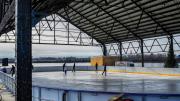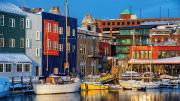Forget lounging on the beach, and suit up instead to explore Portland, Maine, this winter. This dining haven and creative hub might be a lot quieter—and a lot colder—admits longtime resident John Robinson ’90, author of A Concise History of Portland, Maine (2008), but the arts and culinary scenes are thriving.
Theaters, museums, and music halls are all open, he says, as are downtown’s boutiques, cafés, and night clubs. There’s also trekking along the scenic Portland Trails and ice-skating at Thompson’s Point. “People gravitate to Portland in the winter to enjoy the lights, hit the art galleries on the First Friday Art Walks, check out the local microbreweries, and go skiing,” Robinson adds; the city offers anyone “a fun, romantic getaway.”
Or, just come to graze. Portland—rightly named “2018 Restaurant City of The Year” by Bon Appétit—is packed with bakeries, bars, and restaurants, serving everything from South American arepas to fresh ale and oysters to five-course, farm-to-table feasts. “You can’t even get a seat at most places in the summer,” Robinson reports, but “right now, through the end of March, you can walk in and sit at a bar, or get a table any time.”
Do plan ahead, however, for the tenth annual Maine Restaurant Week (March 1-11). The popular event draws crowds by offering specially priced menus, inventive cocktails, and impromptu parties; it’s the perfect opportunity to sample Greater Portland’s finest fare.
The year-round First Friday Art Walk—kicking off 2019 on January 4, February 1, and March 1—is organized by the nonprofit Creative Portland. The evening events take place primarily in the traditional downtown Arts District, where exhibits, readings, concerts, lectures, and performances spotlight the city’s wide-ranging enterprisers.
But increasingly, First Friday also extends beyond the Old Port. Participating arts and incubation venues—like Fork Food Lab, New System Exhibitions, The Apohadion Theater, and Urban Farm Fermentory—have cropped up in the city’s reenergized neighborhoods, like West Bayside and East Bayside, Woodfords Corner, and the East End: signs of an expanding creative economy.
The Maine College of Art (MECA), which redeveloped and moved into a former downtown department store in the late 1990s, has graduated hundreds of students, many of whom stay to work as artists and open businesses and nonprofits across the city, according to Robinson. And in 2018, storefront space in the historic Maine Charitable Mechanics Association building, which formerly housed that artisans’ guild, was renovated and opened by the nonprofit Maine Craft Portland as a retail gallery and arts-resource center. “Art-makers are fighting hard to stay in the city,” he says, a result of the rising housing and living costs associated with the city’s popularity.
The Maine Craft Portland project has been “a big, huge hit,” says Dinah Minot, executive director of Creative Portland, which supports and “promotes the artistic talents and cultural assets of the city.” In addition to anchoring institutions, like the Portland Symphony, Portland Museum of Art, and MECA, which established its The Institute of Contemporary Art (ICA), at MECA in 1997, Minot points to the smattering of smaller and experimental arts and culture organizations, like SPACE, which “showcases some of the hippest output of local art.” All of those, and dozens of others, open their doors for First Fridays and sponsor events year-round, but winter’s a prime time to meet these artmakers and delve unfettered into the arts scene. Says Minot, “You’re going to have 500 people out on the streets, instead of 3,000 to 6,000.” (Check the website for details and a map of First Friday Art Walk events.)
On tap this season at The Portland Museum of Art are “Richard Avedon Portraits, 1952-1970” (through February 17) and “Relational Undercurrents: Contemporary Images of the Caribbean Archipelago” (opening February 1), which explores the fluid boundaries and themes in Latin American art.
The ICA at MECA’s “Drawing Now” exhibit (opening January 17) features a mind-boggling array of works by members of the Drawing Collective, along with guest contributors Josefina Auslender, Kevin Townsend, and Michael Winkler.
On February 17, Creative Portland and the Merrill Auditorium present the inaugural performance-artist showcase “Hear, Here!” “It’s an opportunity for families and everyone to come and see extraordinary talent that they might not have seen before,” Minot says, “either because these artists are on the road during the summer season, or because they’ve recently moved here, attracted by this arts sector. Because this is a destination, beyond lobsters and lighthouses, for people interested in a rich cultural life.”
For more music, check out the historic State Theatre Portland—Walk The Moon, creators of the pop-tune “Shut Up and Dance,” appears January 31—or celebrate Valentine’s Day with a concert by jazz pianist Joey Alexander. More intimate is the Port City Music Hall, where Alsarah & The Nubatones, fronted by the Sudanese-American singer, songwriter, and ethnomusicologist, perform on January 17. Portland’s bars, like The Thirsty Pig, Blue, and the Rí Rá Irish Pub and Restaurant, also host bands and other concerts, as does the Portland House of Music.
This season, The Portland Stage Company presents The Importance of Being Earnest (January 22-February 17) and The Half-Light, a new drama by Monica Wood about “the ghosts that live within us all” (February 26-March 24).
Between shows, there’s plenty of time to tuck in at Portland’s excellent restaurants. Track the newest sites through https://www.portlandfoodmap.com, or consider this short list of Harvard Magazine’s favorite spots downtown or in the Old Port:
The vibrant Central Provisions offers fresh, eclectic small plates, like fried cauliflower, local swordfish, and a foie gras parfait ($4-$26), while Sur-Lie serves elegant tapas in a more reserved setting ($7-$16). At Emilitsa, try grilled eggplant and octopus and other rustic Greek fare ($8-$22), or step into the clean-lined Scandinavian-style décor at Portland Hunt + Alpine Club and feast on Swedish meatballs and gravlax, or share the smörgåsbord: chef’s choice of meats, fish, bread, and aquavit ($5-$48). For more casual dining and a happy late-night bar scene, Taco Escobarr servessuper-fresh tacos, burritos, and the Mexican pork and hominy stew pozole ($8-$14), along with its inventive margaritas including strawberry jalapeño or toasted coconut). Maiz, opened by an entrepreneurial young couple, spotlights Colombian street food and specializes in stuffed arepas: soft corn-based dough cooked on a grill, filled with meat, cheese, or vegetables, and topped with salsa Rosado, chimichurri, or garlic sauce ($6.50-$8.50). For fresh shellfish—from raw oysters to clam chowder and lobster stew—dip into the hip boathouse-styled Eventide Oyster Co. (market-based prices). And don’t miss the seafood and sake at Miyake, arguably the best Japanese restaurant in Maine; owner Masa Miyake (who also operates Pai Men Miyake) creates seasonal menus that incorporate vegetables, herbs, and meat from his own farm ($13-$19, or $60, for a four-course meal).
Local craft breweries abound. You can’t go wrong with any of them, but here are a few to note: Allagash, Bissell Brothers, Foundation, Oxbow, and Rising Tide. Or, board the Maine Brew Bus, which offers a variety of tours in Portland and beyond, for a safe sampling expedition. For rotating craft beers on tap and other wintry concoctions—The Last Meow features catnip-infused gin ($14)—try Bramhall, a candlelit, cave-like hideaway with hearty comfort food, like frito pie, cheeseburgers, and shoestring fries ($8-$12).
For noshing and drinking elsewhere in the city, the chic, airy Drifters Wife (Munjoy Hill section) offers a small, seasonal menu of “new American” food, e.g. bluefish with charred onion and aioli and homemade focaccia ($7-$30), and excellent, all-natural wines. Bao Bao Dumpling House, a West End standout, is a cozy spot for these homemade Chinese staples, along with dim sum and a gingery pork and noodle dish dubbed “ants climbing up a tree” ($6-$16).
How did Portland become a dining destination? “Maine Eats: The Revolution Starts Here,” at The Maine Historical Society through February 9, helps explain the stories behind iconic foods such as blueberries, potatoes, lobsters, and maple syrup—and the origins of whoopee pies, Moxie, and red hot dogs, while “Maine Brews” looks at the state’s prolonged Prohibition Era and the rise, since the 1980s, of more than 120 craft breweries (through January 26).
If trekking around and the chill become too much, hop into Soakology, a tea house and foot spa, or take a load off your mind at Float Harder Relaxation Center. There’s also a day spa at The Francis, boutique lodgings in a historic mansion downtown, although Robinson (and any writer and lover of newspapers), would instead recommend The Press Hotel, located in the former home of Maine’s largest, and still thriving, newspaper, The Portland Press Herald.
Robinson, a self-described “failed novelist” who’s now a commercial real-estate broker, traces the current cultural renaissance to efforts that began in the late 1960s to save the Old Port and all “these brick buildings that are historic and which everybody loves so much” from destruction during the urban-renewal movement.
After World War II, when the Atlantic convoys and an AT&T node left, “the bottom fell out of Portland,” he says, and by the 1960s, “the entire Old Port area was abandoned to motorcycle gangs and a really rough crowd. This place could have been the setting for a good crime novel in the 1970s!” Businessman and landlord Frank Akers (a son of Frank G. Akers Sr., Harvard class of 1925) is credited with buying up the first derelict buildings and claiming that a law prevented “historic buildings from being torn down if they were occupied,” Robinson reports. “He ran newspaper ads in Boston promising ‘Artist Studios’ for $1 per month (no heat!). He strung electric cords with light bulbs through the windows of the open buildings and prevented the buildings from being bulldozed.”
The city government did raze structures—including the old U.S. Post Office, constructed of “the finest Canadian marble,” Robinson adds, to build a parking lot in the heart of the city (now a pocket park). But preservation and redevelopment activism, combined with other factors—The Clean Water Act of 1972, which spurred anti-pollution measures in Casco Bay, and federal investments funneled into the city under then-U.S. senator George Mitchell, among others—helped keep Portland afloat.
Then, in the late 1990s, Maine Medical Center began expanding and MECA opened downtown. “Funky restaurants moved in to take advantage of the Fisherman’s Co-op. The bars in the Old Port cleaned up their acts,” he continues. “The city went from becoming a gutted New England port town to a vibrant center for creative-arts people, chefs, lawyers, and doctors. It is truly an astounding recovery.”





















